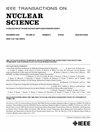结势垒肖特基二极管结构SiC mosfet的单事件效应
IF 1.9
3区 工程技术
Q3 ENGINEERING, ELECTRICAL & ELECTRONIC
引用次数: 0
摘要
本文研究了集成结势垒二极管的SiC MOSFET中的单事件效应(SEEs)[集成JBS结构的MOSFET (JMOS)]。在辐照实验中,随着漏极电压的增加,JMOS漏极到源极的漏电流衰减,最终发生烧坏。辐照过程中栅极泄漏电流基本保持不变,辐照后栅极应力(PIGS)试验中栅极泄漏电流有所增加。解剖分析表明,欧姆接触金属的变形和活性区栅氧化空洞的产生是导致失效的原因。利用Sentaurus技术计算机辅助设计(TCAD)仿真工具,在结势垒肖特基二极管(JBS)结构中,重离子撞击JFET区域中部时,热点集中在欧姆金属角处。此外,当注入位置位于JFET区域的中间时,观察到最大氧化物电场强度显著增加,导致氧化层的潜在损伤,导致最终在pig试验中失效。因此,与传统的SiC JBS和MOSFET器件不同,JMOS表现出独特的失效机制,这是由JBS和MOSFET细胞结构之间的协同相互作用引起的。本文章由计算机程序翻译,如有差异,请以英文原文为准。
Single Event Effect on SiC MOSFETs With Junction Barrier Schottky Diode Structures
This article investigates the single event effects (SEEs) in SiC MOSFETs integrated with a junction barrier diode [MOSFET integrated with JBS structure (JMOS)]. During irradiation experiments, JMOS exhibited drain-to-source leakage current degradation and ultimately experienced burnout as the drain voltage increased. However, the gate leakage current remained almost unchanged throughout the irradiation process but increased under the post-irradiation gate stress (PIGS) test. The anatomical analysis demonstrated that the deformation of ohmic contact metal and the generation of gate oxide voids in the active region were the causes of failures. By employing Sentaurus technical computer-aided design (TCAD) simulation tools, hot spots were concentrated at ohmic metal corners when the heavy ions struck in the middle of the JFET region in the junction barrier Schottky diode (JBS) structure. In addition, a remarkable increase in the maximum oxide electric field strength was observed when the injection position was located in the middle of the JFET region, which led to the potential damage of the oxide layer, resulting in the final failure under the PIGS test. Therefore, different from conventional SiC JBS and MOSFET devices, JMOS exhibited a unique failure mechanism arising from the synergistic interaction between both JBS and MOSFET cell structures.
求助全文
通过发布文献求助,成功后即可免费获取论文全文。
去求助
来源期刊

IEEE Transactions on Nuclear Science
工程技术-工程:电子与电气
CiteScore
3.70
自引率
27.80%
发文量
314
审稿时长
6.2 months
期刊介绍:
The IEEE Transactions on Nuclear Science is a publication of the IEEE Nuclear and Plasma Sciences Society. It is viewed as the primary source of technical information in many of the areas it covers. As judged by JCR impact factor, TNS consistently ranks in the top five journals in the category of Nuclear Science & Technology. It has one of the higher immediacy indices, indicating that the information it publishes is viewed as timely, and has a relatively long citation half-life, indicating that the published information also is viewed as valuable for a number of years.
The IEEE Transactions on Nuclear Science is published bimonthly. Its scope includes all aspects of the theory and application of nuclear science and engineering. It focuses on instrumentation for the detection and measurement of ionizing radiation; particle accelerators and their controls; nuclear medicine and its application; effects of radiation on materials, components, and systems; reactor instrumentation and controls; and measurement of radiation in space.
 求助内容:
求助内容: 应助结果提醒方式:
应助结果提醒方式:


